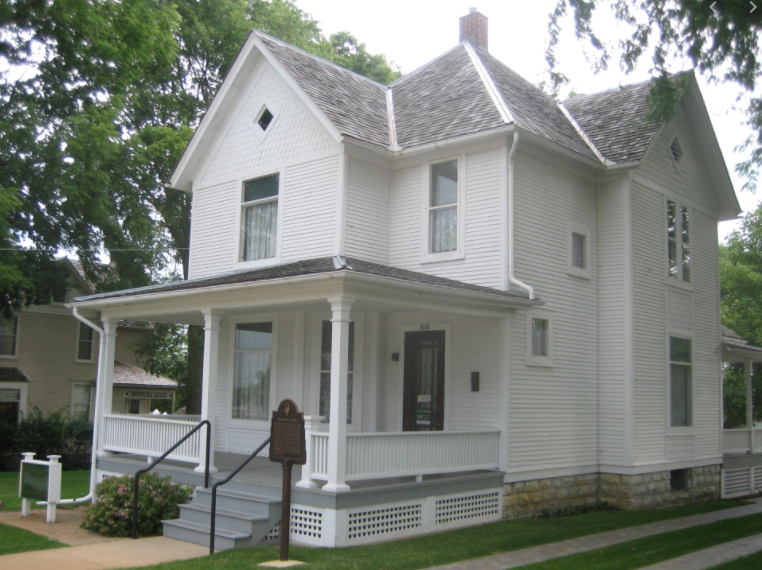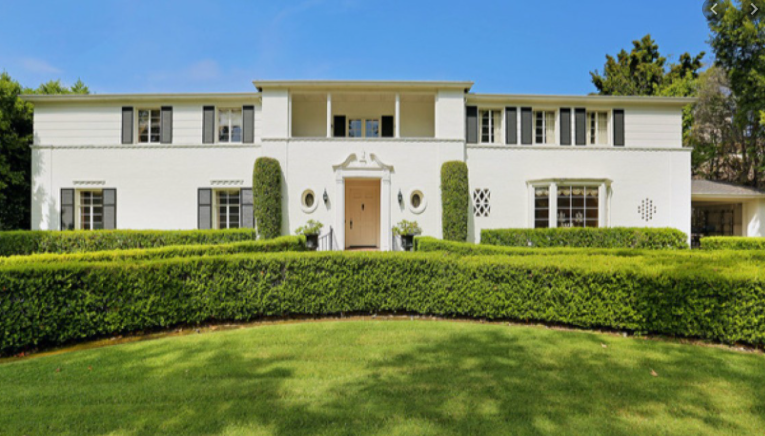
The Ronald Reagan Boyhood Home is the house located at 816 South Hennepin Avenue, Dixon, Illinois, in which the 40th President of the United States Ronald Reagan lived as a youth beginning in 1920. The building was listed on the National Register of Historic Places in 1982. The home is open to visitors from April to October.

In the posh Westside pocket called Little Holmby, a home with presidential pedigree just surfaced for sale. The Colonial Revival-style spot was the marital home of Ronald Reagan and Jane Wyman, and it’s currently on the market for $6.75 million. The property has seen some action as of late, selling for $6.45 million two years ago, the Los Angeles Times previously reported. That’s quite an uptick compared with the $12,800 it cost it build in 1938. An up-and-coming movie star at the time, Reagan bought the house with Wyman in the 1940s. Wyman, an Oscar-winning actress, retained the property following their divorce in 1949.
Ronald Wilson Reagan (/ˈreɪɡən/ RAY-gən; February 6, 1911 – June 5, 2004) was an American politician who served as the 40th president of the United States from 1981 to 1989 and became a highly influential voice of modern conservatism. Prior to his presidency, he was a Hollywood actor and union leader before serving as the 33rd governor of California from 1967 to 1975.
Reagan was raised in a low-income family in small towns of northern Illinois. He graduated from Eureka College in 1932 and worked as a radio sports commentator. After moving to California in 1937, he found work as an actor and starred in a few major productions. As president of the Screen Actors Guild, Reagan worked to root out communist influence. In the 1950s, he moved into television and was a motivational speaker at General Electric factories. In 1964, his speech “A Time for Choosing” earned him national attention as a new conservative spokesman. Building a network of supporters, Reagan was elected governor of California in 1966. As governor, he raised taxes, turned a state budget deficit to a surplus, challenged the protesters at UC Berkeley, and ordered in National Guard troops during a period of protest movements.
In 1980, Reagan won the Republican presidential nomination and defeated the incumbent president, Jimmy Carter. At 69 years, 349 days of age at the time of his first inauguration, Reagan was the oldest person to assume the U.S. presidency, a distinction he held until 2017, when Donald Trump was inaugurated at age 70 years, 220 days. Reagan faced former vice president Walter Mondale when he ran for re-election in 1984 and defeated him, winning the most electoral votes of any U.S. president, 525, or 97.6% of the 538 votes in the Electoral College. It was the second-most lopsided presidential election in modern U.S. history after Franklin D. Roosevelt‘s 1936 victory over Alfred M. Landon, in which he won 98.5%, or 523, of the (then-total) 531 electoral votes.[5]
Immediately on taking office as president, Reagan began implementing sweeping new political and economic initiatives that were highly popular among conservatives but denounced by liberals. Reagan won over enough conservative Democrats to pass his program through Congress. Economic conditions had deteriorated under Carter, with slow growth and high inflation. Reagan promised that his supply-side economic policies, dubbed “Reaganomics“, would turn around the economy with lower tax rates, economic deregulation, and reduction in government spending. However conditions remained harsh until they finally turned as promised in time for his reelection in 1984. Over his two terms, the economy saw a reduction of inflation from 12.5% to 4.4% and an average real GDP annual growth of 3.6%. Reagan enacted cuts in domestic discretionary spending, cut taxes, and increased military spending, which contributed to increased federal debt overall. In his first term, he survived an assassination attempt, spurred the War on Drugs, and fought public sector labor unions.
In foreign affairs he denounced Communism and invaded the island country of Grenada after Communist elements took control; as a result a new government was appointed by the governor-general. With the economy booming again, foreign affair crises dominated his second term. Major concerns were the bombing of Libya, the Iran–Iraq War, the Iran–Contra affair, and the renewed Cold War. In June 1987, four years after he publicly described the Soviet Union as an “evil empire“, Reagan challenged Soviet leader Mikhail Gorbachev to “tear down this wall!“, during a speech at the Berlin Wall. He transitioned Cold War policy from détente to rollback by escalating an arms race with the USSR. He then engaged in talks with Gorbachev that culminated in the INF Treaty, which shrank both countries’ nuclear arsenals. Reagan began his presidency during the decline of the Soviet Union. The Cold War ended in October 1989 and Soviet communism suddenly collapsed in 1991.
When Reagan left office in January 1989, he held an approval rating of 68%, matching those of Franklin D. Roosevelt, and later Bill Clinton, as the highest ratings for departing presidents in the modern era.[6] Although he had planned an active post-presidency, Reagan disclosed in November 1994 that he had been diagnosed with Alzheimer’s disease earlier that year. Afterward, his informal public appearances became more infrequent as the disease progressed. He died at home on June 5, 2004. His tenure constituted a realignment toward conservative policies in the United States, and he is an icon among conservatives. Evaluations of his presidency among historians and the general public place him among the upper tier of American presidents.